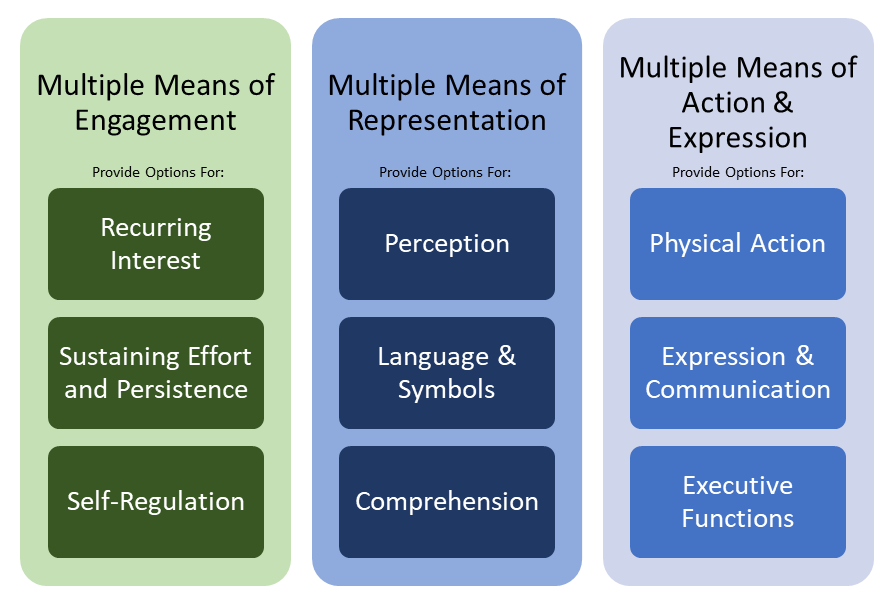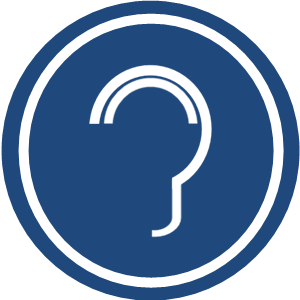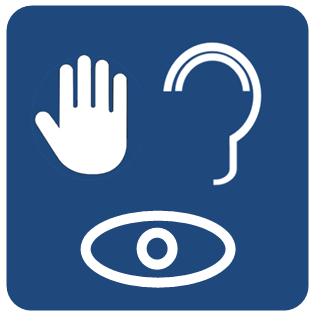Accessibility for Sensory and Communication Challenges in Autism
Kelly Machado and Brittany Spina
Introduction
![]() Autism Spectrum Disorder (ASD) is a complex neurodevelopmental condition characterized by differences in social interaction, communication, and behaviour (Lord et al., 2020). Individuals with ASD experience unique challenges that affect how they communicate, engage socially, and process sensory information, which in turn influences their educational experiences. Thus, early intervention, specifically through inclusive education, is important to ensure that all students have equal access to educational opportunities (Lord et al., 2020). In recent years, there has been a noticeable increase in the number of students with ASD in mainstream classrooms, which has led educators to confront new demands in creating inclusive learning environments. This is especially apparent in K-12 educational settings, where educators are expected to accommodate a wide range of learning needs and sensory profiles. However, many educators find themselves unprepared, lacking sufficient training or clear guidance on how to support these students effectively. Consequently, many schools struggle to meet the needs of students with ASD. It is universally acknowledged that more action is needed to promote inclusion, as this can lead to increased social engagement, stronger peer relationships, and, ultimately, long-term academic success (Lindsay et al., 2013). Moreover, individuals with ASD often encounter barriers in educational settings that can hinder their academic performance and decrease social integration, with adverse effects on emotional well-being (Azuka et al., 2024). To support these individuals effectively, educators must go beyond simple accommodations and adopt proactive, individualized teaching approaches (Ker & van Gorp, 2024). By critically examining the accessibility barriers faced by learners with ASD, particularly those related to sensory processing, such as auditory, visual, and tactile challenges, this analysis proposes practical instructional design strategies and digital tools that create inclusive, engaging, and supportive learning environments.
Autism Spectrum Disorder (ASD) is a complex neurodevelopmental condition characterized by differences in social interaction, communication, and behaviour (Lord et al., 2020). Individuals with ASD experience unique challenges that affect how they communicate, engage socially, and process sensory information, which in turn influences their educational experiences. Thus, early intervention, specifically through inclusive education, is important to ensure that all students have equal access to educational opportunities (Lord et al., 2020). In recent years, there has been a noticeable increase in the number of students with ASD in mainstream classrooms, which has led educators to confront new demands in creating inclusive learning environments. This is especially apparent in K-12 educational settings, where educators are expected to accommodate a wide range of learning needs and sensory profiles. However, many educators find themselves unprepared, lacking sufficient training or clear guidance on how to support these students effectively. Consequently, many schools struggle to meet the needs of students with ASD. It is universally acknowledged that more action is needed to promote inclusion, as this can lead to increased social engagement, stronger peer relationships, and, ultimately, long-term academic success (Lindsay et al., 2013). Moreover, individuals with ASD often encounter barriers in educational settings that can hinder their academic performance and decrease social integration, with adverse effects on emotional well-being (Azuka et al., 2024). To support these individuals effectively, educators must go beyond simple accommodations and adopt proactive, individualized teaching approaches (Ker & van Gorp, 2024). By critically examining the accessibility barriers faced by learners with ASD, particularly those related to sensory processing, such as auditory, visual, and tactile challenges, this analysis proposes practical instructional design strategies and digital tools that create inclusive, engaging, and supportive learning environments.
Theoretical Framework

This analysis is grounded in the principles of Universal Design for Learning (UDL), an educational framework designed to support the diverse and individualized needs of learners (CAST, 2024). UDL encourages a reevaluation of traditional teaching methods, enabling educators to better support students with varying abilities, backgrounds, and preferences (Al Taqatqa, 2022). By promoting flexible learning environments that deliver content in multiple formats and prioritizing various modes of representation, UDL creates a more inclusive educational experience. Research by Ok et al. (2017) highlights that implementing UDL principles, such as providing multiple means of action and expression, can significantly enhance learning outcomes. This approach enables learners to engage through methods that align with their strengths, ultimately helping to eliminate the barriers common in more traditional educational models. At its core, UDL aims to design educational experiences that proactively address learner variability. This framework supports the current research by offering a lens through which to examine accessibility challenges and inclusive teaching strategies. In particular, it highlights the importance of understanding the specific sensory challenges that learners with ASD encounter in educational settings.
Sensory Challenges
Learners with ASD often face significant accessibility challenges in educational settings. Research indicates that many individuals with ASD experience atypical responses to sensory input, which can significantly impact learning, behaviour, attention, and communication (Mallory & Keehn, 2021). Individuals who have difficulty processing sensory information in their environment may experience challenges in attending to stimuli relevant to learning (Kinnealey et al., 2012). Given that classrooms typically contain a lot of visual clutter and expose students to unpredictable tactile and auditory stimuli, excessive noise in these environments is known to adversely impact learners’ attention and behaviour (Ashburner et al., 2008). Therefore, to create inclusive and accessible learning environments, it is essential to understand the specific sensory processing challenges faced by individuals with ASD, including those related to visual, auditory, and tactile input.
Auditory Processing
 Children with ASD often experience challenges with auditory filtering, which is the brain’s ability to detect, discriminate, and focus on relevant sounds while ignoring background noise. Difficulties in this area are common among autistic learners and have been closely linked to academic underachievement (James et al., 2022). Research indicates that auditory stimuli significantly hinder the engagement, behaviour, and academic performance of students with ASD (Ashburner et al., 2008). In particular, background noise in the classroom, especially when combined with verbal instruction, has been identified as a significant stressor that triggers increases in restrictive and repetitive behaviours (RRBs) and contributes to poorer academic outcomes (Keith et al., 2019; Kinnealey et al., 2012). Students with ASD who struggle to attend to verbal instructions amid noisy environments are, therefore, at greater risk of underperforming in school. Hypersensitivity to auditory stimuli is also frequently linked to avoidant behaviours, which negatively impact learning outcomes (Kinnealey et al., 2012). Many of those students seek predictable, repetitive input through sensory-seeking behaviours as a way to manage overwhelming sensory experiences (Ashburner et al., 2008). Moreover, difficulties with auditory filtering are associated with deficits in concentration and learning, creating additional challenges for children with ASD (Ashburner et al., 2008). Alongside these auditory concerns, visual processing is another critical factor to consider when designing inclusive classroom environments for students with ASD.
Children with ASD often experience challenges with auditory filtering, which is the brain’s ability to detect, discriminate, and focus on relevant sounds while ignoring background noise. Difficulties in this area are common among autistic learners and have been closely linked to academic underachievement (James et al., 2022). Research indicates that auditory stimuli significantly hinder the engagement, behaviour, and academic performance of students with ASD (Ashburner et al., 2008). In particular, background noise in the classroom, especially when combined with verbal instruction, has been identified as a significant stressor that triggers increases in restrictive and repetitive behaviours (RRBs) and contributes to poorer academic outcomes (Keith et al., 2019; Kinnealey et al., 2012). Students with ASD who struggle to attend to verbal instructions amid noisy environments are, therefore, at greater risk of underperforming in school. Hypersensitivity to auditory stimuli is also frequently linked to avoidant behaviours, which negatively impact learning outcomes (Kinnealey et al., 2012). Many of those students seek predictable, repetitive input through sensory-seeking behaviours as a way to manage overwhelming sensory experiences (Ashburner et al., 2008). Moreover, difficulties with auditory filtering are associated with deficits in concentration and learning, creating additional challenges for children with ASD (Ashburner et al., 2008). Alongside these auditory concerns, visual processing is another critical factor to consider when designing inclusive classroom environments for students with ASD.
Visual Processing
 Visual sensory input also plays a significant role in the educational experiences of students with ASD. While devices designed for these learners often use bright lights and vivid colours to capture attention and support learning, such stimuli can overwhelm visually oversensitive children (Noureddine, 2024). Classroom lighting, in particular, has a notable impact on learning outcomes. Many students with ASD are sensitive to light, which can be distracting or even painful (Kinnealey et al., 2012). For instance, although natural sunlight through windows can have positive effects, excessive exposure may cause glare that is difficult for students with light sensitivity to tolerate (Mallory & Keehn, 2021). Similarly, exposure to bright, flickering, or fluorescent lights has been linked to increased repetitive behaviours (Kinnealey et al., 2012). The overall visual environment also affects attention; heavily decorated classrooms with colourful displays, common in many schools, can distract students, reducing on-task behaviour and negatively impacting academic performance (Mallory & Keehn, 2021). In addition to these visual factors, the tactile environment also influences how students engage and interact within the classroom setting.
Visual sensory input also plays a significant role in the educational experiences of students with ASD. While devices designed for these learners often use bright lights and vivid colours to capture attention and support learning, such stimuli can overwhelm visually oversensitive children (Noureddine, 2024). Classroom lighting, in particular, has a notable impact on learning outcomes. Many students with ASD are sensitive to light, which can be distracting or even painful (Kinnealey et al., 2012). For instance, although natural sunlight through windows can have positive effects, excessive exposure may cause glare that is difficult for students with light sensitivity to tolerate (Mallory & Keehn, 2021). Similarly, exposure to bright, flickering, or fluorescent lights has been linked to increased repetitive behaviours (Kinnealey et al., 2012). The overall visual environment also affects attention; heavily decorated classrooms with colourful displays, common in many schools, can distract students, reducing on-task behaviour and negatively impacting academic performance (Mallory & Keehn, 2021). In addition to these visual factors, the tactile environment also influences how students engage and interact within the classroom setting.
Tactile Processing
 Tactile input sensitivity can interfere with the effective use of communication tools, such as touchscreens and augmentative and alternative communication (AAC) devices, which are not designed to accommodate sensory diversity (Noureddine, 2024). Children with ASD often experience significant difficulties with touch processing (Mallory & Keehn, 2021). Many individuals with ASD experience either heightened or diminished sensitivity to tactile input, which can make interacting with such devices uncomfortable or ineffective (Noureddine, 2024). For example, a hypersensitive learner may find the lightest touch overwhelming, while a hyposensitive learner might struggle to register touch on a device (Noureddine, 2024). These sensory differences are crucial in shaping how individuals with ASD interact in the classroom, as they can create barriers to engagement with both educational tools and peers (Mallory & Keehn, 2021). Additionally, children with tactile sensitivity are often less attentive and more easily distracted by classroom stimuli (Ashburner et al., 2008). They may also face difficulties participating in activities involving different materials, such as cotton and glue, which can heighten sensory discomfort (Mallory & Keehn, 2021). These challenges are understood not just as behavioural issues but as neurological differences in sensory integration, further reinforcing the need for sensory-informed pedagogy (Robertson & Baron-Cohen, 2017).
Tactile input sensitivity can interfere with the effective use of communication tools, such as touchscreens and augmentative and alternative communication (AAC) devices, which are not designed to accommodate sensory diversity (Noureddine, 2024). Children with ASD often experience significant difficulties with touch processing (Mallory & Keehn, 2021). Many individuals with ASD experience either heightened or diminished sensitivity to tactile input, which can make interacting with such devices uncomfortable or ineffective (Noureddine, 2024). For example, a hypersensitive learner may find the lightest touch overwhelming, while a hyposensitive learner might struggle to register touch on a device (Noureddine, 2024). These sensory differences are crucial in shaping how individuals with ASD interact in the classroom, as they can create barriers to engagement with both educational tools and peers (Mallory & Keehn, 2021). Additionally, children with tactile sensitivity are often less attentive and more easily distracted by classroom stimuli (Ashburner et al., 2008). They may also face difficulties participating in activities involving different materials, such as cotton and glue, which can heighten sensory discomfort (Mallory & Keehn, 2021). These challenges are understood not just as behavioural issues but as neurological differences in sensory integration, further reinforcing the need for sensory-informed pedagogy (Robertson & Baron-Cohen, 2017).
Proposed Solutions
Supporting students with ASD in educational settings requires a multifaceted approach that addresses individual sensory needs. Adequate support involves modifying the classroom environment, implementing sensory-based Interventions, and incorporating technology. Collectively, these approaches create a more accessible, engaging and inclusive learning experience by reducing sensory overload and enhancing self-regulation and engagement.
Classroom Modifications
 Modifications to the educational environment are essential for supporting students with sensory processing difficulties, enabling greater success both in the short term and over time (Kinnealey et al., 2012). To guide these efforts, applying UDL principles can be especially effective, as they promote the use of alternative tools for lighting, sound, and touch to enhance accessibility and meet diverse sensory needs (Mallory & Keehn, 2021). Sensory-based adaptations, such as installing sound-absorbing walls and using lower-intensity lighting, have been shown to benefit students with visual and auditory processing challenges, significantly improving their attention and engagement (Kinnealey et al., 2012). Enhancing the signal-to-noise ratio by amplifying relevant speech or reducing ambient background noise helps students with ASD better process speech in noisy environments (Ashburner et al., 2008). Similarly, minimising visual distractions can enhance attention and engagement for students with ASD (Mallory & Keehn, 2021). Carefully considering the quantity and quality of visual and auditory stimuli while limiting exposure to classroom distractions is critical to improving accessibility (Mallory & Keehn, 2021).
Modifications to the educational environment are essential for supporting students with sensory processing difficulties, enabling greater success both in the short term and over time (Kinnealey et al., 2012). To guide these efforts, applying UDL principles can be especially effective, as they promote the use of alternative tools for lighting, sound, and touch to enhance accessibility and meet diverse sensory needs (Mallory & Keehn, 2021). Sensory-based adaptations, such as installing sound-absorbing walls and using lower-intensity lighting, have been shown to benefit students with visual and auditory processing challenges, significantly improving their attention and engagement (Kinnealey et al., 2012). Enhancing the signal-to-noise ratio by amplifying relevant speech or reducing ambient background noise helps students with ASD better process speech in noisy environments (Ashburner et al., 2008). Similarly, minimising visual distractions can enhance attention and engagement for students with ASD (Mallory & Keehn, 2021). Carefully considering the quantity and quality of visual and auditory stimuli while limiting exposure to classroom distractions is critical to improving accessibility (Mallory & Keehn, 2021).
In addition to these modifications, flexible seating options, such as wobble chairs or stability balls, may support students in regulating their arousal levels and sustaining attention during instruction. The gentle movement provided by these seating options allows students to self-regulate sensory input, resulting in increased on-task and in-seat behaviour (Fedewa & Erwin, 2011; Wong, 2023). These tools can be a valuable component of inclusive classroom design that supports sensory needs, resulting in positive outcomes for both educators and students.
Sensory-Based Interventions
 Various instructional strategies show promise for addressing sensory challenges in educational settings. For instance, the Sensory Activity Schedule (SAS) is a structured approach developed to enhance participation and task performance (Mills & Chapparo, 2018). The SAS is a collaborative intervention involving occupational therapists, students, and teachers. This approach includes tailored sensory activities, such as movement and touch, along with environmental adjustments that align with individual sensory needs (Mills & Chapparo, 2018). Sensory activities are scheduled to support students based on sensory or environmental triggers and are therefore provided at times when they can best help students engage effectively with targeted tasks (Mills & Chapparo, 2018). This design utilises available space and equipment. A research study by Mills and Chapparo (2018) used a semi-structured interview process to explore the effects of SAS on students with ASD. Results demonstrated improvements in student behaviour, attention, and engagement during educational tasks, underscoring the importance of collaborating with teachers to help students appropriately process sensory information within school settings (Mills & Chapparo, 2018). These results highlight the importance of sensory-based interventions for students with ASD.
Various instructional strategies show promise for addressing sensory challenges in educational settings. For instance, the Sensory Activity Schedule (SAS) is a structured approach developed to enhance participation and task performance (Mills & Chapparo, 2018). The SAS is a collaborative intervention involving occupational therapists, students, and teachers. This approach includes tailored sensory activities, such as movement and touch, along with environmental adjustments that align with individual sensory needs (Mills & Chapparo, 2018). Sensory activities are scheduled to support students based on sensory or environmental triggers and are therefore provided at times when they can best help students engage effectively with targeted tasks (Mills & Chapparo, 2018). This design utilises available space and equipment. A research study by Mills and Chapparo (2018) used a semi-structured interview process to explore the effects of SAS on students with ASD. Results demonstrated improvements in student behaviour, attention, and engagement during educational tasks, underscoring the importance of collaborating with teachers to help students appropriately process sensory information within school settings (Mills & Chapparo, 2018). These results highlight the importance of sensory-based interventions for students with ASD.
Additional research supports the effectiveness of similar structured sensory interventions. For example, Brainworks is a classroom-based sensory program for students with sensory processing differences. Brainworks incorporates structured brain and sensory breaks, utilises sensory equipment, and implements classroom modifications such as dimmed lighting and calming music to support self-regulation and engagement. Research reveals observable improvements in student performance in these areas. These findings suggest that sensory-based programs can enhance educational outcomes, helping students build self-awareness and regulation skills, which in turn support long-term academic and developmental success (Wild & Steeley, 2018). Building on the effectiveness of sensory-based interventions, technology-based interventions provide additional support for students in managing sensory input.
Technology-Based Interventions
 Technology offers valuable tools to support students with ASD who face sensory processing challenges. Sensory-friendly apps like Calm and Headspace for Kids provide guided mindfulness and relaxation techniques, including breathing exercises and visualizations, that help students manage sensory overload and anxiety. Additionally, wearable devices, such as brain-sensing headbands, offer real-time feedback on stress levels, allowing students to become more aware of their sensory states and proactively practice self-regulation strategies. When combined with environmental modifications, such as interactive sensory rooms, these sensory processing support tools foster a more productive learning experience for students with ASD (Choudhury, 2024). Specialized wearable technologies and adaptive clothing can also provide calming pressure, reduce sensory distractions, and regulate temperature. Some wearable devices include sensors that monitor physiological signals such as heart rate and respiration, enabling real-time stress detection and supporting self-regulation through alerts sent to smartphones (Koo et al., 2018). For example, the KeepCalm app offers in-the-moment strategy suggestions based on heart rate and past behavioural data. Since research suggests that heart rate reduction may be a significant predictor of intervention effectiveness, this technology-driven approach helps alleviate the burden on educators by providing more objective data collection and personalized support grounded in observable and internal cues (Ezie et al., 2024). Additional features, such as sound reduction, tactile customization, and temperature control, further aid in managing sensory overload.
Technology offers valuable tools to support students with ASD who face sensory processing challenges. Sensory-friendly apps like Calm and Headspace for Kids provide guided mindfulness and relaxation techniques, including breathing exercises and visualizations, that help students manage sensory overload and anxiety. Additionally, wearable devices, such as brain-sensing headbands, offer real-time feedback on stress levels, allowing students to become more aware of their sensory states and proactively practice self-regulation strategies. When combined with environmental modifications, such as interactive sensory rooms, these sensory processing support tools foster a more productive learning experience for students with ASD (Choudhury, 2024). Specialized wearable technologies and adaptive clothing can also provide calming pressure, reduce sensory distractions, and regulate temperature. Some wearable devices include sensors that monitor physiological signals such as heart rate and respiration, enabling real-time stress detection and supporting self-regulation through alerts sent to smartphones (Koo et al., 2018). For example, the KeepCalm app offers in-the-moment strategy suggestions based on heart rate and past behavioural data. Since research suggests that heart rate reduction may be a significant predictor of intervention effectiveness, this technology-driven approach helps alleviate the burden on educators by providing more objective data collection and personalized support grounded in observable and internal cues (Ezie et al., 2024). Additional features, such as sound reduction, tactile customization, and temperature control, further aid in managing sensory overload.
The combined strategies discussed above, including classroom modifications, sensory-based interventions, and technology-based interventions, create a more inclusive and responsive classroom environment that addresses the diverse sensory needs of students with ASD, ultimately promoting their success and well-being in the classroom.
Limitations and Considerations
Various limitations and considerations must be taken into account when implementing and collecting data on the effects of instructional design strategies, such as the Sensory Activity Schedule (SAS) or other environmental modifications. Research emphasises the crucial role of teacher training and ongoing support in successfully implementing classroom-based interventions (Mills & Chapparo, 2018). However, a gap exists between the extensive training that therapists and other professionals receive and the more limited training provided to teachers in school settings. For example, while occupational therapists receive in-depth education on sensory processing and its impact on students’ academic and behavioural performance, teachers often lack this specialised background knowledge. Considering the complexity of ASD and its unique sensory characteristics, expecting teachers to implement sensory interventions tailored to individual students without additional training or coaching may be impractical (Mills & Chapparo, 2018). Although behaviour assessments are widely used to identify the functions of behaviour and develop function-based treatment plans, many behaviour plans overlook sensory factors that may underlie certain behaviours due to a limited understanding of sensory assessment and intervention techniques. This oversight may contribute to the limited effectiveness of some interventions for children with ASD, as they fail to address underlying sensory issues that contribute to behaviours perceived as disruptive, especially within the classroom setting (Schilling & Schwartz, 2004).
Additionally, broader systemic barriers within educational settings significantly limit the successful adoption of evidence-based ASD interventions. Wilson and Landa (2019) identify these barriers as insufficient educator preparation, a lack of administrator support, limited resources, and discrepancies between educators’ and administrators’ perceptions of implementation challenges. Many teachers report feeling underprepared to meet the diverse needs of students with ASD due to insufficient pre-service training and professional development opportunities. This gap results in decreased motivation and confidence to implement specialised interventions effectively. Furthermore, administrative support is often inconsistent, which contributes to a lack of cohesion and alignment within educational teams. Resource constraints further impede the feasibility of sustained intervention use in classroom environments. Finally, discrepancies between educators’ and administrators’ perceptions of implementation barriers create communication gaps and misaligned priorities, hindering coordinated efforts to overcome obstacles (Wilson & Landa, 2019). Collectively, these factors present substantial challenges, underscoring the need for systemic changes in policy, training, and resource allocation to facilitate the effective implementation of ASD instructional strategies in schools. Addressing these root issues through improved collaboration, enhanced professional development, and consistent leadership support is crucial for bridging the gap between research and practice in ASD education (Proctor et al., 2011).
Conclusion
Supporting children with ASD requires more than physical accommodations; it demands a comprehensive, inclusive approach that addresses sensory and environmental challenges. Sensory processing differences across auditory, visual, and tactile domains significantly impact student engagement, behaviour, and learning outcomes. By applying UDL principles, educators can proactively reduce barriers through classroom modifications, structured sensory-based interventions, and the integration of technology. While these strategies provide valuable resources for supporting students with ASD, successful implementation depends on effective teacher training and collaboration with specialists. Addressing these gaps ensures interventions are not only evidence-based but also practical and sustainable within classroom contexts. Ultimately, inclusive instructional design is not merely beneficial but is also essential for all students. By embedding accessibility into the foundation of teaching practice, educators can create environments where every student has the opportunity to engage, participate, and thrive.
References
Al Taqatqa, F. A. S. (2023). The Efficiency of a UDL-based Program in Developing Language Skills and Social Interaction for Students With ASD. Information Sciences Letters: An International Journal, 12(3), 1457-1468
Ashburner, J., Ziviani, J., & Rodger, S. (2008). Sensory Processing and Classroom Emotional, Behavioral, and Educational Outcomes in Children With Autism Spectrum Disorder. The American Journal of Occupational Therapy, 62(5), 564–573. https://doi.org/10.5014/ajot.62.5.564
Azuka, C. V., Wei, C. R., Ikechukwu, U. L., & Nwachukwu, E. L. (2024). Inclusive Instructional Design for Neurodiverse Learners. Basic and Applied Education Research Journal, 5(2), 59-67. https://doi.org/10.11594/baer.05.02.01
CAST. (2025). Universal Design for Learning guidelines version 2.2. http://udlguidelines.cast.org
Choudhury, R. (2024). Technology-enhanced learning for students with autism. International Research Journal of Humanities and Social Sciences, 5(11). https://doi-ds.org/doilink/11.2024-21974583/IRJHIS2411003
Ezie, R., Kamel, R., Dunphy, M., Young, A., & Nuske, H. J. (2024). Using heart rate and behaviors to predict effective intervention strategies for children on the autism spectrum: Validation of a technology-based intervention. Sensors, 24(24), 8024. https://doi.org/10.3390/s24248024
Fedewa, A. L., & Erwin, H. E. (2011). Stability balls and students with attention and hyperactivity concerns: Implications for on-task and in-seat behavior. American Journal of Occupational Therapy, 65(4), 393–399. https://doi.org/10.5014/ajot.2011.000554
James, P., Schafer, E., Wolfe, J., Matthews, L., Browning, S., Oleson, J., Sorensen, E., Rance, G., Shiels, L., & Dunn, A. (2022). Increased rate of listening difficulties in autistic children. Journal of Communication Disorders, 99, 106252. https://doi.org/10.1016/j.jcomdis.2022.106252
Keith, J. M., Jamieson, J. P., & Bennetto, L. (2019). The Influence of Noise on Autonomic Arousal and Cognitive Performance in Adolescents with Autism Spectrum Disorder. Journal of Autism and Developmental Disorders, 49(1), 113–126. https://doi.org/10.1007/s10803-018-3685-8
Ker, G., & van Gorp, R. (2024). Quality education for all: a case study of success for a neurodivergent learner. Frontiers in Sustainability, 5, 1399361.
Kinnealey, M., Pfeiffer, B., Miller, J., Roan, C., Shoener, R., & Ellner, M. L. (2012). Effect of Classroom Modification on Attention and Engagement of Students With Autism or Dyspraxia. The American Journal of Occupational Therapy, 66(5), 511–519. https://doi.org/10.5014/ajot.2012.004010
Koo, S. H., Kim, G., Rivera, S., Pan, T., & Fong, D. (2018). Wearable technology design for autism spectrum disorders. Archives of Design Research, 31(1), 37–55. https://doi.org/10.15187/adr.2018.02.31.1.37
Lindsay, S., Proulx, M., Thomson, N., & Scott, H. (2013). Educators’ challenges of including children with autism spectrum disorder in mainstream classrooms. International Journal of Disability, Development and Education, 60(4), 347–362. https://doi.org/10.1080/1034912X.2013.846470
Lord, C., Brugha, T. S., Charman, T., Cusack, J., Dumas, G., Frazier, T., Jones, E. J. H., Jones, R. M., Pickles, A., State, M. W., Taylor, J. L., & Veenstra-VanderWeele, J. (2020). Autism spectrum disorder. Nature Reviews Disease Primers, 6(1), 5. https://doi.org/10.1038/s41572-019-0138-4
Mallory, C., & Keehn, B. (2021). Implications of sensory processing and attentional differences associated with autism in academic settings: An integrative review. Frontiers in Psychiatry, 12, 695825. https://doi.org/10.3389/fpsyt.2021.695825
Mills, C., & Chapparo, C. (2018). Listening to teachers: Views on delivery of a classroom-based sensory intervention for students with autism. Australian Occupational Therapy Journal, 65(1), 15–24. https://doi.org/10.1111/1440-1630.12381
Noureddine, N. (2024). Addressing Accessibility Challenges in Mobile Technology for Children with Autism Spectrum Disorder: Issues and Potential Solutions. In Power, R. (Ed.), The ALT Text: Accessible Learning with Technology. Power Learning Solutions. https://pressbooks.pub/thealttext/chapter/addressing-accessibility-challenges-in-mobile-technology-for-children-with-autism-spectrum-disorder-issues-and-potential-solutions/
Ok, M. W., Rao, K., Bryant, B. R., & McDougall, D. (2017). Universal design for learning in pre-k to grade 12 classrooms: A systematic review of research. Exceptionality, 25(2), 116-138
Proctor, E., Silmere, H., Raghavan, R. et al. Outcomes for Implementation Research: Conceptual Distinctions, Measurement Challenges, and Research Agenda. Adm Policy Ment Health 38, 65–76 (2011). https://doi-org.uproxy.library.dc-uoit.ca/10.1007/s10488-010-0319-7
Robertson, C. E., & Baron-Cohen, S. (2017). Sensory perception in autism. Nature Reviews Neuroscience, 18(11), 671–684. https://doi.org/10.1038/nrn.2017.112
Schilling, D. L., & Schwartz, I. S. (2004). Alternative seating for young children with autism spectrum disorder: Effects on classroom behavior. Journal of Autism and Developmental Disorders, 34(4), 423–432. https://doi.org/10.1023/B:JADD.0000037418.48587.f4
Wild, G., & Steeley, S. L. (2018). A Model for Classroom-Based Intervention for Children with Sensory Processing Differences. International Journal of Special Education, 33(3), 745-.
Wilson, K. P., & Landa, R. J. (2019). Barriers to educator implementation of a classroom-based intervention for preschoolers with autism spectrum disorder. Frontiers in Education, 4, Article 27. https://doi.org/10.3389/feduc.2019.00027
Wong, L. H. G. (2023). Sensory-Based Interventions for Managing Difficulties of Children with Autism Spectrum Disorder at School. Current Developmental Disorders Reports, 10(4), 240–249. https://doi.org/10.1007/s40474-023-00288-2
